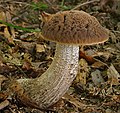Leccinellum
| Leccinellum | ||||||||||||
|---|---|---|---|---|---|---|---|---|---|---|---|---|

Gelbporiger Raufuß ( Leccinellum crocipodium ) |
||||||||||||
| Systematics | ||||||||||||
|
||||||||||||
| Scientific name | ||||||||||||
| Leccinellum | ||||||||||||
| Bresinsky & Manfr. binder |
Leccinellum is a fungal genus of the family of Dickröhrlingsverwandten (Boletaceae). The shape of the fruiting bodies is very similar to the species from the genus Leccinum , but all parts of the fruiting body have a yellow pigment. If it is only weakly developed or if it only appears temporarily on individual parts, the top layer of the hat consists of chains with spherical cells. In addition, the meat often changes color quickly and evenly intensively in the air, for example first reddish, violet, lilac and finally gray or blackish. The species of the genera Leccinum and Leccinellum are also known as "Rauffuß", short for "Raufußröhrlinge", or "Raustielröhrlinge" due to the scaly / rough stem surface in the German-speaking area.
The type species is the yellow- pored grouse ( Leccinellum crocipodium ).
features
Macroscopic features
The soft-fleshed fruiting bodies of the Leccinellum species have the same habitus as the Raustielröhrlinge from the genus Leccinum . They are divided into a stem and hat and have a layer of tubes on the underside of the hat . The domed hat does not have a narrow, skin-shaped hem (not appended) on the edge. While the tubes between the handle and the edge of the hat arch in a pillow-like manner, they bulge out like a trench around the tip of the handle. The stems are long and elongated compared to the hat. They have a stalked bark with a striped structure and covered with rough scales. These rib-like strips are often more or less distinctly network-like connected with each other, with the scales mainly concentrating on the ribs. The fungi are either clearly yellow in color in all parts of the fruiting body or have only hinted at and limited to certain parts and stages of development of yellow hues, such as pale yellowish-white or yellowish-gray stems, pale gray-yellowish-straw-colored or dirty yellow-gray Tubular, sometimes ocher-yellow hats in places or an occasional pale yellowish flesh over the tubes. The flesh of some species changes color noticeably quickly and very quickly and completely reddish, violet or lilac and finally gray to blackish on contact with atmospheric oxygen.
Microscopic features
Hat covering layer made of chains of spherical cells or of broad, short-linked hyphae. The chains sometimes ending with dermatocystids and mixed in with slender, long-linked, narrower hyphae. L. albellum is a largely white species of the genus without yellow pigments, but, like L. griseum , has the characteristic spherical cells in the top layer of the hat.
ecology
The Raufussröhrlinge from the genus Leccinellum are mycorrhizal fungi , some of which are closely linked to certain higher plants . Except for the species Leccinellum rhodoporosum described in Japan, the species are distributed throughout the Holarctic .
species
Eight species are currently known worldwide:
| German name | Scientific name | Author quote |
|---|---|---|
| Leccinellum albellum | (Peck 1888) Bresinsky & Manfred Binder 2003 | |
| Hornbeam hornbeam | Leccinellum pseudoscabrum | (Roman Schulz 1924) Bresinsky & Manfred Binder 2003 |
| Rockrose Ruffle | Leccinellum corsicum | (Rolland 1896) Bresinsky & Manfred Binder 2003 |
| Yellow-pored ruffle | Leccinellum crocipodium | (Letellier 1838) Della Maggiora & Trassinelli 2014 |
| Green oak grouse | Leccinellum lepidum | (H. Bouchet ex Essette 1965) Bresinsky & Manfred Binder 2003 |
| Leccinellum quercophilum | Michael Kuo 2013 | |
| Leccinellum rhodoporosum | (Haruki Takahashi) Haruki Takahashi 2016 | |
| Leccinellum viscosum | (Halling & B. Ortiz 2009) Mikšík 2016 |
Hornbeam hornbeam,
Leccinellum carpiniRockrose Ruff
Leccinellum corsicumGelbporiger Raufuß
Leccinellum crocipodiumGreen
oak grouse Leccinellum lepidum
meaning
All Raufussröhrlinge are edible, but are for the most part rare or of no particular value. Some species are valued edible mushrooms. All species of the genus are under nature protection in Germany and may only be collected in small quantities for personal consumption.
Individual evidence
- ↑ a b c Andreas Bresinsky, Helmut Besl: Contributions to a Mykoflora Germany: Key to the genus determination of the leaf, bar and tube mushrooms with references to the species identification. New taxa and new combinations: Leccinellum Bresinsky & Binder gen. Nov. In: Regensburger Mykologische Schriften . tape 11 , 2003, p. 231-233 .
- ↑ Michael Kuo, Andrew S. Methven, Andrew M. Minnis, Roy E. Halling: Studies of North American macrofungi, 1. Validation of Lactarius rubidus comb. nov. and Leccinellum quercophilum sp. nov. In: Mycotaxon . tape 124 , April – June, 2013, pp. 323–332 , doi : 10.5248 / 124.323 ( fs.fed.us [PDF; 1.9 MB ]).
- ↑ Michal Mikšík: Index Fungorum no. 304. September 8, 2016, accessed on March 6, 2017 .




